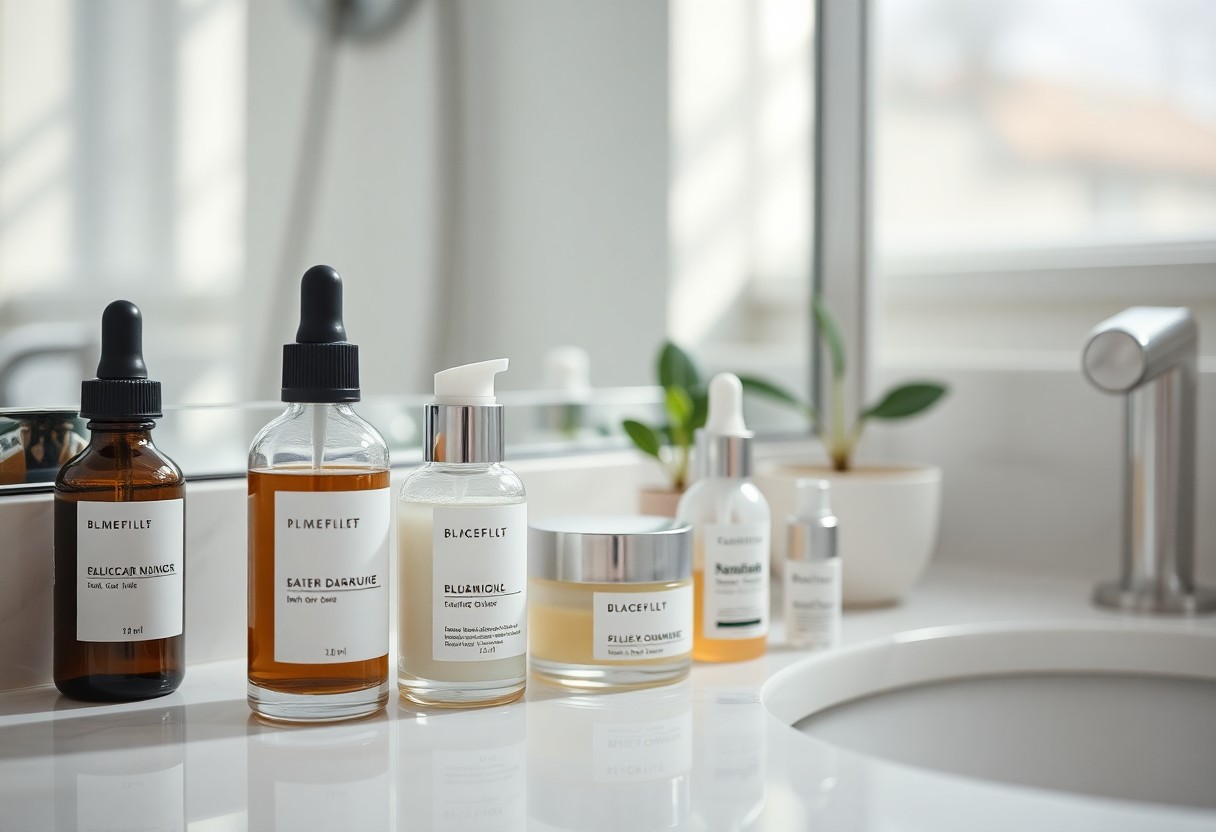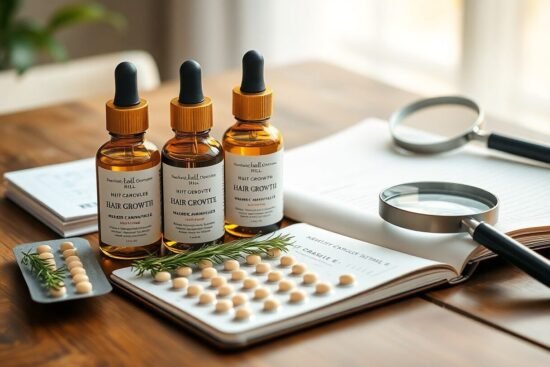
Moisturizers are an necessary part of any skincare regimen, but how you layer them with treatments can significantly impact their effectiveness. In this post, I will share my insights on optimizing your routine to achieve glowing skin. By understanding the proper order and compatibility of products, you can enhance absorption and boost your skin’s overall health. If you want to tackle specific concerns while maintaining hydration, following the right layering techniques will transform your skincare game and deliver impressive results.
Key Takeaways:
- Always apply products in the right order, starting with the thinnest consistency, such as serums, followed by creams and oils.
- Moisurizers should be applied when the skin is slightly damp to lock in hydration more effectively.
- Different skin types may require different layering techniques; customize your routine according to whether your skin is oily, dry, or combination.
- Introduce new products gradually into your routine, monitoring for any skin reactions or sensitivities.
- Layering treatments that target specific concerns, like acne or pigmentation, can be beneficial, but it’s important to check product compatibility.
- Don’t over-layer, as using too many products at once can lead to irritation; focus on key ingredients that work well together.
- Always finish with sunscreen during the day, as even the best skincare routine can be undone by sun exposure.


Crafting an Effective Layering Strategy
Building an effective layering strategy can transform your skincare routine into a powerhouse of hydration and efficacy. Start by applying products in order of their molecular weight, allowing lighter formulations to penetrate the skin before applying heavier ones. Typically, you should begin with cleansers and toners, followed by serums, treatments, and finishing with moisturizers and oils. This sequence maximizes absorption and ensures each product delivers its intended benefits without interference from heavier layers that might block lighter ones.
The Importance of Order in Skincare
Establishing the right order in your skincare routine might seem simple, yet it significantly impacts how well your products perform. Lightest to heaviest layers help maximize absorption—products like water-based serums should be applied before emollient-based creams to encourage deeper penetration. If applied incorrectly, you risk wasting products or compromising their efficacy, which can ultimately hinder results.
Choosing Complementary Products
Selecting products that work well together can elevate your skincare game. For instance, if you’re using a vitamin C serum known for its brightening properties, pairing it with a hydrating hyaluronic acid serum can enhance its effectiveness while preventing dryness. Look for formulations that share similar goals and ingredient compatibility to boost overall results.
In my experience, the harmony between products is as necessary as their individual efficacy. Take time to check for potential conflicts—some acids can destabilize other ingredients if layered incorrectly. For example, combining niacinamide and vitamin C in the same routine is often questioned due to their perceived interaction, but formulated correctly, they can work together to target multiple skin concerns. Furthermore, aligning your product’s pH levels will promote a more synergistic effect. Aim for a thoughtful combination, and don’t hesitate to test how your skin reacts to different pairings over time.
The Science of Active Ingredients
Active ingredients are the powerhouse components in skincare that drive results, addressing concerns like aging, acne, and hyperpigmentation. Each ingredient has a unique mechanism of action; for instance, retinol promotes cell turnover while hyaluronic acid attracts moisture to the skin. Understanding these interactions allows me to maximize the benefits I receive from my skincare regimen, ensuring that each product I choose aligns with my skin goals. Knowledge of these actives can be a game-changer in achieving radiant, healthy skin.
Understanding Synergy and Interaction
Synergy occurs when two or more ingredients work together to enhance each other’s effects. For example, combining vitamin C with ferulic acid can boost antioxidant protection and improve skin clarity. Recognizing these beneficial pairings allows me to create a more effective routine. Some combinations can significantly increase the overall efficacy without causing irritation.
Avoiding Conflict: What to Keep Apart
Certain active ingredients can clash, leading to irritation or diminished effects. For instance, I avoid layering retinol with AHAs or BHAs, as the combination can be too harsh for the skin and may cause redness or peeling. Additionally, mixing vitamin C with niacinamide historically raised concerns about their compatibility, even though recent studies suggest they might be used together effectively. Knowing these conflicts helps create a more balanced and gentle skincare routine, tailored to my skin’s unique needs.
Some ingredient conflicts require particular attention. For example, using BHA or AHAs alongside vitamin C can increase the risk of skin irritation due to their exfoliating nature. Similarly, layering multiple actives like retinol and exfoliating acids could weaken the skin barrier, resulting in redness and sensitivity. By being mindful of these combinations, I can prevent discomfort while achieving the best results possible from my skincare arsenal.
Moisturizers: More Than Just Hydration
Moisturizers play a pivotal role in skincare, offering benefits that extend beyond mere hydration. While their primary function is to keep the skin moisturized, they also help to lock in important nutrients, protect the skin barrier, and even target specific skin concerns. When selected thoughtfully, a moisturizer can enhance the overall efficacy of your skincare routine and work synergistically with other treatments.
Types of Moisturizers and Their Functions
In my experience, understanding the different types of moisturizers can guide your selection process. Here’s a breakdown:
| Type | Function |
| Creams | Provide intense hydration and nourishment for dry skin. |
| Lotions | Lightweight moisture ideal for combination and oily skin types. |
| Gels | Fresh and non-greasy hydration, perfect for oily skin. |
| Oils | Lock moisture in while providing additional nutrients. |
| Balms | Seal and protect on very dry or compromised skin. |
- Intense hydration for dry skin
- Lightweight moisture for combination skin
- Fresh hydration for oily skin
- Lock moisture with important nutrients
- Seal and protect compromised skin
Recognizing the variety of moisturizing products available allows you to target your unique skincare needs effectively.
Enhancing Penetration: Techniques for Optimal Absorption
Applying moisturizer appropriately can significantly enhance its absorption and effectiveness. To maximize penetration, consider using warm water to create a humid environment, which helps to open up pores. Additionally, layering your treatments from thinnest to thickest texture ensures that each product doesn’t interfere with the absorption of the next. I often find that gently pressing the moisturizer into the skin rather than rubbing helps it penetrate more deeply.
Incorporating techniques such as applying your moisturizer immediately after cleansing—while skin is still damp—can boost its effectiveness. I like to use the “patting” method, lightly pressing my fingers against my skin to drive the product deeper and promote absorption. Using a facial steamer prior to application can also help temporarily open your pores and optimize the moisture uptake. These techniques not only enhance absorption but also elevate your skincare experience and results.
Timing Matters: Optimal Application Methods
Layering products in your skincare routine isn’t solely about the order; timing plays a significant role too. Applying products at specific intervals allows your skin to fully absorb each treatment before adding another layer. I recommend waiting a few minutes between each step, especially for potent actives like serums and treatments, ensuring their efficacy isn’t compromised. For lighter formulations, like gels or essences, I often opt for less waiting time, as they tend to absorb faster, making my routine more efficient.
Day vs. Night: Adjusting Your Routine
Your skincare routine needs to shift depending on the time of day. Mornings focus on protective elements such as antioxidants and broad-spectrum SPF, while evenings should prioritize repair and recovery with restorative ingredients like retinol or peptides. I find it beneficial to use lightweight, hydrating formulas during the day and richer, more emollient products at night to support my skin’s natural regeneration process.
Seasonal Adjustments for Skin Health
Seasonal changes can significantly impact your skin’s behavior and needs. In colder months, I often switch to thicker, more occlusive moisturizers to combat dryness, while summer calls for lighter textures, such as gels or lotions. Transitioning my products lets your skin remain balanced and responsive throughout the year, rather than succumbing to the various environmental stressors.
To effectively adapt your skincare for seasonal changes, pay attention to the fluctuations in humidity and temperature. For instance, during winter, heating indoors can strip moisture from your skin, necessitating heavy-duty occlusives and oils to lock in hydration. Conversely, high humidity in the summer often calls for hydration without excess oil, making gel creams an ideal choice. Regularly assessing your skin’s needs against weather changes ensures a healthier, more resilient complexion year-round.
Common Missteps in Layering
Layering can either elevate your skincare routine or sabotage it, depending on how you approach it. Many individuals fall into common traps, such as using too many products or applying them in the wrong order. Ignoring your skin’s unique needs can lead to a compromised barrier, causing irritation or breakouts. Understanding these missteps is the first step toward achieving that coveted radiant complexion.
Overloading Your Skin: Signs to Watch For
You might be overloading your skin if you notice persistent redness, excessive oil production, or dry patches. These signs suggest your skin is reacting negatively to the product cocktail you’ve created. Listening to your skin is important; if it starts to feel uncomfortable, you might need to simplify your routine and reduce the number of layers.
The Myth of “More is Better”: Finding Balance
The idea that slathering on more products will yield better results is a common misconception. In reality, less can be more. Finding the right balance between hydration, treatment, and protection not only makes application more effective but also prevents your skin from becoming overwhelmed. A streamlined approach, focusing on important products tailored to your skincare needs, often leads to better results than a heavy-handed application.
Many of us assume that piling on multiple serums, creams, and treatments will accelerate results. However, skin can only absorb so much at a time. Overapplying can create a barrier, inhibiting the absorption of the beneficial ingredients you’re trying to introduce. Instead, look for key ingredients that address your concerns, and focus on those rather than layering too many products. Quality over quantity truly makes a difference, so choose wisely to achieve optimal skin health without the excess.
To wrap up
To wrap up, effectively layering treatments and moisturizers in your skincare routine can significantly enhance the results you achieve. I recommend starting with lighter, water-based serums to target specific skin concerns, followed by thicker creams to lock in moisture. By understanding the order of application, you can ensure that each product works effectively, allowing your skin to absorb the beneficial ingredients fully. Your unique skin type will guide your choices, so don’t hesitate to adjust your routine as needed for optimal results.
FAQ
Q: What is the ideal order to layer treatments and moisturizers in my skincare routine?
A: The ideal order generally follows this pattern: cleanse, tone (if using), apply targeted treatments (like serums or essences), followed by moisturizers. If you are using sunscreen, it should be the final step in the morning. This layering ensures that each product can effectively penetrate the skin without being layered over too many barriers.
Q: Can I layer different types of moisturizers, like creams and gels?
A: Yes, layering different types of moisturizers can be beneficial. Start with a lightweight gel moisturizer to provide hydration without feeling heavy, and follow it with a cream for added moisture and barrier protection. This approach allows your skin to benefit from the lightweight hydration as well as the occlusive properties of thicker creams.
Q: Should all skincare products be applied on damp skin?
A: Not all products need to be applied on damp skin, but applying treatments and serums on slightly damp skin can often enhance absorption. However, heavier moisturizers are best applied on dry skin to ensure they lock in moisture rather than dilute it. Find a balance that works for your skin and the products you’re using.
Q: How long should I wait between applying different products?
A: It’s generally advised to wait around 1 to 3 minutes between applying different products to allow each one to absorb properly before moving onto the next. This waiting time helps maximize the efficacy of each layer without overwhelming your skin’s ability to absorb and utilize the ingredients.
Q: Can certain active ingredients in treatments affect how I layer products?
A: Yes, some active ingredients can influence how you layer your products. For example, ingredients like retinoids, acids (AHAs/BHAs), and vitamin C should not be mixed, as they can cause irritation or reduce effectiveness. It’s best to use these types of ingredients in separate routines or on alternating days to avoid complications.
Q: Is it necessary to use both a serum and a moisturizer in my routine?
A: While it’s not absolutely necessary to use both a serum and a moisturizer, incorporating both can provide more comprehensive care. Serums often contain higher concentrations of active ingredients targeting specific skin concerns, while moisturizers help to hydrate and seal in that moisture. Using both can enhance the overall effectiveness of your skincare regimen.
Q: How do I know if my product layering is too much for my skin?
A: Signs that your layering might be too intensive for your skin include excessive dryness, redness, irritation, or breakouts. If you notice any of these reactions, consider simplifying your routine, reducing the number of products used, or applying them less frequently. Listening to your skin is key in establishing the right balance for your treatment layering.











